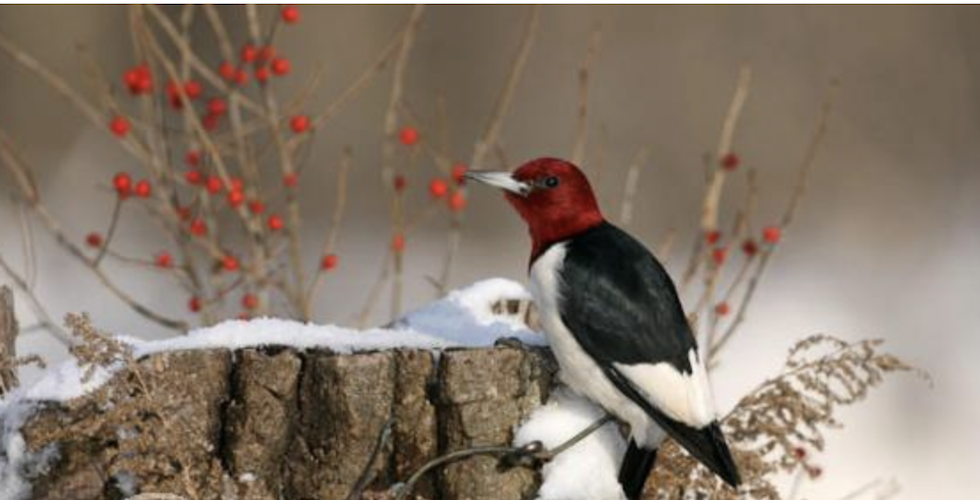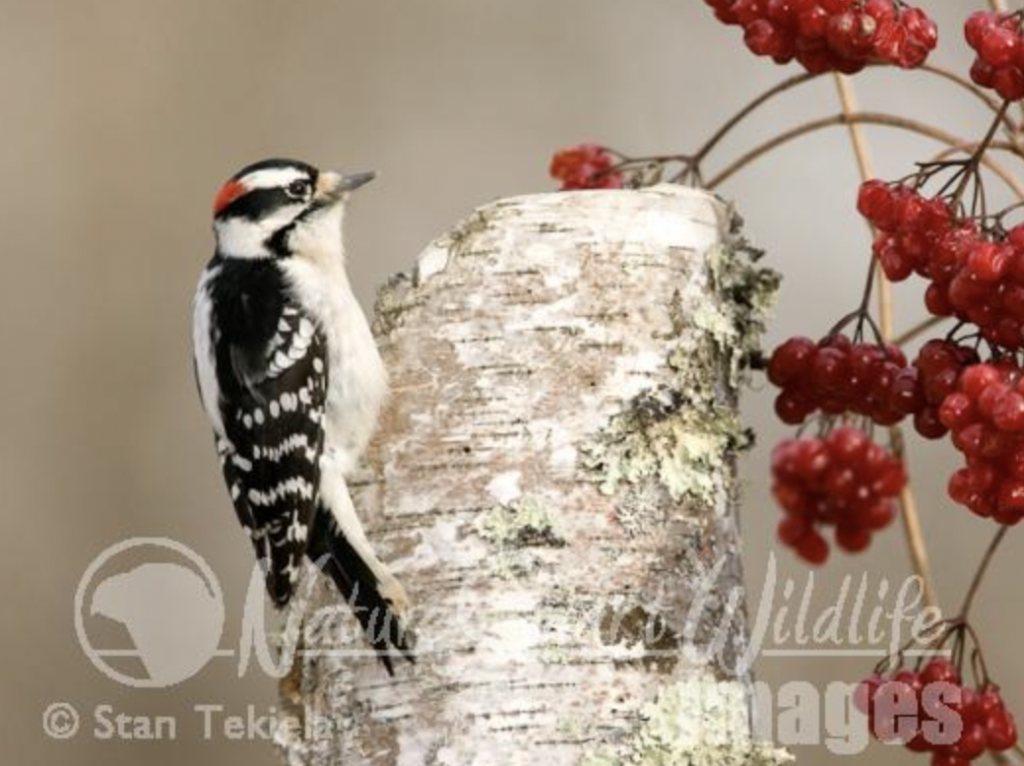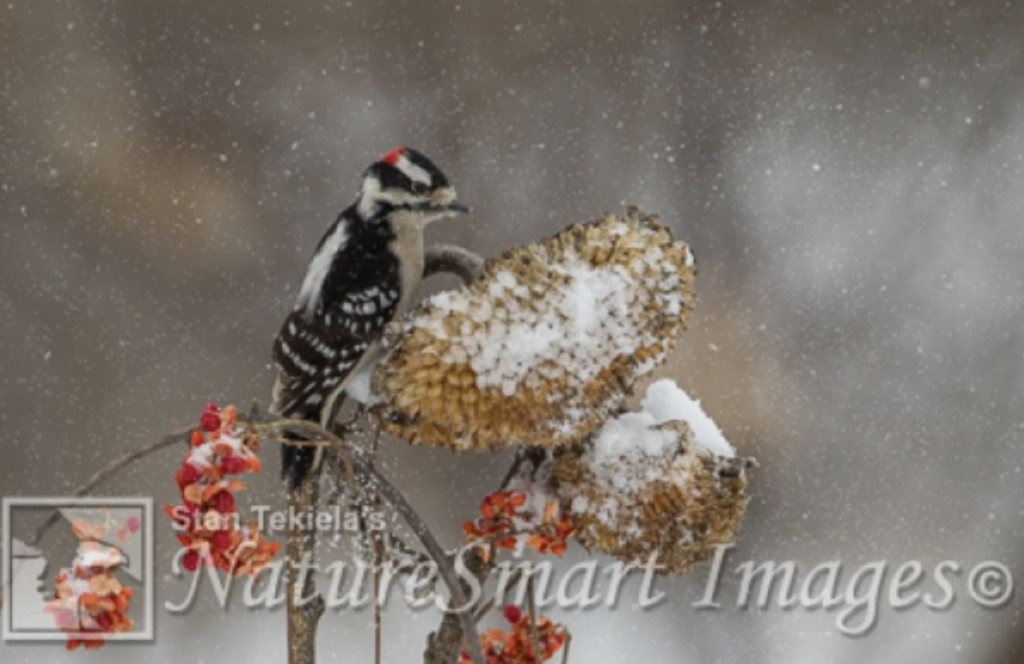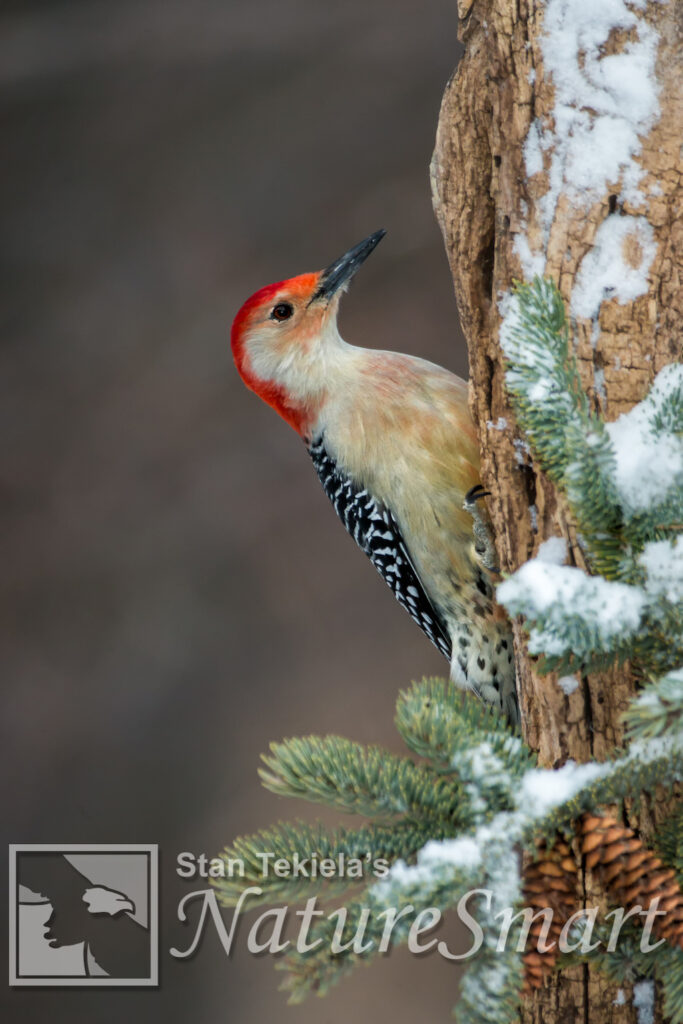
Did You Know that Woodpeckers Have Unique Behaviors? Award-winning writer and photographer Stan Tekiela tells us all about it.
Once again, I found myself sitting outside in my small photo blind, trying to capture a handful of images of birds in a winter/snowy setting. The temperatures were a balmy minus five below zero, and I was starting to feel the cold penetrate my many layers of clothing.
I was fortunate enough to have a few distinct species of woodpeckers come to my feeding station, and I wanted to capture a couple of images of these birds. But, of course, my mind started to wander, and I began to think about all the unique and exciting adaptations and behaviors of woodpeckers.

Let’s start with one of the woodpeckers’ more unique behaviors. You might not give this much thought, but the way that woodpeckers land on a tree is unusual. When a woodpecker lands, it is on a vertical surface, like the trunk of a tree. All other birds land on a horizontal surface, such as a branch, with the aid of gravity. Woodpeckers land on the vertical surface of the tree by clinging to the tree as if gravity doesn’t exist. They can do this because they have specialized feet. Their toes are different from most other birds. They have two toes pointing forward and two toes pointing backward. Other birds have three toes forward and only one backward. The second toe pointing backward gives the woodpeckers a greater ability to cling to the sides of trees, defying gravity.

Woodpeckers have extremely stiff tail feathers, which also play a crucial role in the bird’s ability to cling to the side of a tree. The feet are only two legs of the tripod that the woodpecker needs to cling to a vertical surface. The tail is the third leg and is essential. The bird pushes so hard on the tail that the feathers often bend under pressure.
The fact that woodpeckers excavate holes in trees is unique. Even more impressive is that they excavate these cavities with their face. They use their beak, comparable to our teeth, to chisel holes in trees. If you don’t think this is amazing, I challenge you to pick up a piece of firewood and excavate a hole in it with any part of your body.

Sure, excavating holes in trees is amazing, but taking it one step further, they do this without suffering any brain injury (concussion). Studies show that, on average, a woodpecker pecks or drums on the hard surface of a tree about 12,000 strikes per day. That’s many impacts for the brain to endure! So how do they accomplish this without damaging their brain? As with most things in nature, the answer is a combination of factors.
First, the woodpecker’s brain has a smooth surface, allowing for more contact with the inside of the skull. This might seems counterintuitive, but having a brain that sloshes around the head isn’t suitable for high impacts. Woodpeckers have extraordinarily little space between the skull and brain, called the subdural space, and therefore don’t have much cerebrospinal fluid, unlike our skull and brain. Again, this helps to stabilize the brain within the skull.
The bird’s bill is located in a position that allows the maximum force from the impact to be concentrated just below the brain. Woodpeckers also have tongues so long that the tongue leaves the mouth of the bird and wraps around the outside of the skull, helping cushion the brain.
The size of a woodpecker’s brain is relatively small and therefore doesn’t have much mass. Since the brain is lightweight, it doesn’t build up enough force to cause damage to the brain upon impact. Woodpeckers also have a small cushion-like material between the bill and skull that helps to absorb each impact. All these things add up to a woodpecker who doesn’t get a concussion when it bangs its face against a tree. This is just the beginning of how different woodpeckers are from other birds. This is why I will gladly sit in subzero temperatures to capture a few images of the amazing woodpeckers.
If you enjoyed Stan’s post, you might consider one of his amazing nature books: Bald Eagles, Wild Birds, or Backyard Birds: Welcomed Guests at our Gardens and Feeders.
You can follow Stan on Facebook and Twitter, or contact him via his web page. Stan’s nationally syndicated NatureSmart Column appears in more than 25 cities spanning 5 states (Minnesota, Wisconsin, Michigan, Illinois, and Pennsylvania) and is circulated to more than 750,000 readers.
For more stories about wildlife and nature, sign up for our newsletter now!



Annie long
This is utterly fascinating! I love woodpeckers, too. Now i know a smidgen about how wonderful and unique they really are. And they are quite beautiful. We have a mated pair of Pileated Woodpeckers who live on the mountain near us. We hear them calling almost daily, but we only see them occasionally. When I hear a call close by I run outside to look in the sky for them. Sometimes I am lucky and I can see one fly to a perch on a tree within my sight range.
Liliane Opsomer
Indeed it is quite amazing the protection they have when hammering their beak into the tree bark. They are such fascinating birds.